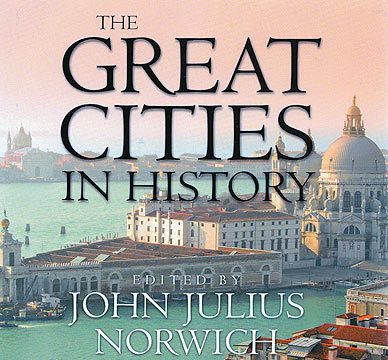The Great Cities in History is one of those books that are meant to be gifted: substantial, rich in colour and apparently uncontroversial. Norwich is a prolific author, documentary filmmaker, art dealer and conservationist. In this volume, he has got historians, archaeologists, anthropologists, conservators and journalists, from Western Europe and the US, to write on nearly 70 cities; illustrated with paintings, drawings, etchings, maps, artistic reconstructions, movie stills and photographs, including a classic one of Shanghai by Henri Cartier-Bresson.
Perhaps the most daunting of Norwich’s tasks must have been to shortlist the cities and restricting the essays. He uses history to justify his selection and limit the scope of each write-up. He divides the book into: Ancient World, Cities of the First Millennium AD, Medieval and Early Modern Worlds, concluding with 18 modern cities.
His choice, he says, is based on the relative importance of the cities in their times. He naturally begins with Uruk in Mesopotamia, the ‘first city in the world’, and not surprisingly concludes with Shanghai, ‘China’s Super-city.’ Using these criteria he is able to accommodate Memphis, which was a capital for three and half millennia, as well as New Delhi, a planned capital city, less than a century old. Athens, with its monumental remains and rich literature, can be included in the same section as Timbuktu, which was ‘one part history and two parts myth’. It is also a useful tool to restrict the history of cities; for example, Jerusalem’s ends with its destruction by the Romans in the first century AD. Other cities with shorter histories like Paris and London get included twice for different periods. The only other city accorded this privilege is Istanbul/ Constantinople. New York (which, along with four other North American and five European cities, is included in the modern section) gets back-to-back essays.
Norwich points out that the net is cast wider as the book moves forward. This he attributes to civilisational developments. For instance, his inclusion of “no fewer than four Islamic” cities in the second section, he says, throws “into sharp relief the superiority of the Arab-Moorish civilisations during those centuries”. The ‘superior civilisation’ argument is problematic when we notice that not a single city from Africa is included after the medieval period. If pre-war Berlin, Sydney or even Copenhagen could be included, why not Beirut, Cairo or Johannesburg in Early Modern and Modern Cities? Unless these cities didn’t lie within the ‘civilisational’ markets the publishers were targeting.
“The book can indeed be seen as a work of history,” Norwich says. But he adds that “above all it is about people: how they work and play, worship; and how they have tackled the greatest of all social problems: to live together in close proximity, yet in harmony…” If these are serious criteria, one is surprised at the omission of Calcutta, Bombay and most of all Banaras, one of the cities with a longest uninterrupted history as pilgrim city. Unfortunately, history, as recorded in the book, doesn’t lend itself easily to romanticism. If harmony was the keyword, how come so many pre-modern cities were walled for military reasons?
The book includes an image of one of Saddam Hussein’s palaces towering over Nebuchadnezzar’s palace in Babylon. Saddam legitimised himself by symbolically linking himself not only to Hammurabi but also to Alexander, who chose Babylon as his eastern capital, and this helped preserve the remains of the ancient city. Subsequently, however, massive areas have been levelled for military purposes and archaeological remains have been annihilated by the movement of armoured vehicles over the ‘Processional Way’ on which Alexander and Darius walked. Civili-sations can also cannibalise great cities.
Perhaps it is unfair to level political arguments against a book whose biases are obvious: “If I were banned from London and if Australia were not quite so far away from Europe, it is in Sydney that I should wish to live.”




